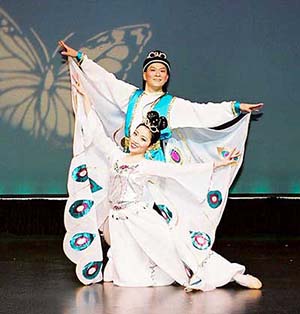The
Butterfly Lovers is a Chinese legend about the tragic romance between two
lovers, Liang Shanbo and Zhu Yingtai, or Liang Zhu, from whom the name of
the legend is known in Chinese (Liáng Shanbó yu Zhù Yingtái, often
abbreviated as Liáng-Zhù). The legend is often regarded as the Chinese
equivalent to Romeo and Juliet.
The story is set in the Eastern Jin Dynasty. A young woman named Zhu Yingtai from Shangyu, Zhejiang, disguised herself as a man traveling to Hangzhou to study. During her journey, she met and joined Liang Shanbo, a companion schoolmate from Kuaiji (Kuàiji, now known as Suzhou) in the same province. They studied together for three years, during which their relationship strengthened. When the two parted, Zhu offered to arrange for Liang to marry her 59-old fictitious sister. When Liang traveled to Zhu’s home, he discovered her true gender. Although they were devoted and passionate about each other at that point, Zhu was already engaged with Ma Wencai (Ma Wéncái), a man her parents had arranged for her to be married to. Depressed, Liang died in office as a county magistrate. On the day Zhu was to be

Scene from the ballet “Butterfly
Lovers”
married to Ma, whirlwinds prevented the wedding procession from escorting Zhu beyond Liang’s tomb. Zhu left the procession to pay her respects for Liang.
Liang’s tomb split apart, and Zhu dived into it to join him. A pair of butterflies emerged from the tomb and flew away.
The
earliest record of the legend can be traced back to late Tang Dynasty. In
Records of the Xuan Hall (Xuanshì Zhì), the author Zhang Du (Zhang Dú,
flourished ca. 850-880) wrote:
Yingtai,
the daughter of the Zhu family in Shangyu, dressed as a man in disguise,
studied with Liang Shanbo from Kuaiji. Shanbo’s courtesy name was Churen
(Chùrén). Zhu Yingtai returned home first. Two years later, Liang Shanbo
visited her, only to find that she was a woman, thus suffered from
feelings of loss. [Liang Shanbo] asked [Zhu’s] parents if he could marry
her, but her family had already vowed to marry her to the Ma family.
Shanbo took the post of magistrate at Yin (Yín, Western part of today’s
Ningbo), later died in office, and was buried somewhere west of the city
of Mao (Mào, Eastern part of today’s Ningbo). When Zhu Yingtai was
escorted to the Ma family by a boat, the boat stopped at a tomb, could not
move further due to the winds and waves. After learning that it belonged
to Liang Shanbo, Zhu Yingtai landed and cried, the ground opened by
itself; Zhu Yingtai was thus buried within. Xie An, then the Chancellor of
China, proclaimed the tomb as the “Tomb of the Righteous Woman”.

